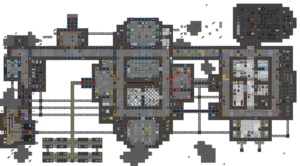Old Station: Difference between revisions
(removes ai core mentions PR#12815) |
No edit summary |
||
| Line 1: | Line 1: | ||
{{Needs revision | |||
|reason = Stub page, needs way more information | |||
|user = LoliconSlayer | |||
}} | |||
{{Location | {{Location | ||
|headerbgcolor=black | |headerbgcolor=black | ||
Revision as of 22:05, 19 March 2022

|
This page needs revising!
The following page is out of date and/or needs to be revised. If the page's guide needs revision, see here for an example. |
| Prototype Nanotrasen Research Station | |
| An early iteration of Nanotrasen's research space stations | |
| Purpose: | Originally research and development for Nanotrasen, but now the station is in a state of disrepair and needs work to be restored |
| Key items: | Many rare building materials, an R&D lab, and all the necessary components for a singularity engine |
| Workers: | Multiple Nanotrasen employees in cryostasis that can wake at any moment |
| Access: | Anyone willing to explore space, or any of the employees that exit cryostasis on board |
| Exits: | Space, or successfully repairing the station and building a teleporter |
| Outside | |
One of, if not the first space station research facility created by Nanotrasen long before the existence of Space Station 13. The facility originally consisted of four smaller sub-stations connected by transit tubes, or slender hallways. These compact sub stations were known as Alpha, Beta, Charlie and Delta station respectively and each served contained departments that synergized well with one another to keep total size of each station to a minimum.
The research done on the station covers multiple areas as indicated by the experimental projects room containing a wide array of "advanced" prototype inventions. these inventions, namely the singularity beacon further suggest that work on Plasma was being undertaken long before its existence was publicly disclosed. In addition to plasma research, the existence of an Artificial Program core room onboard the facility indicates that Nanotrasen most likely had access to experimental technologies long before they were made public.
